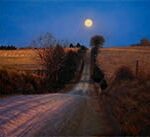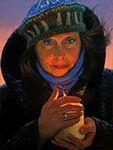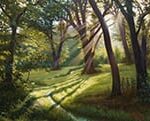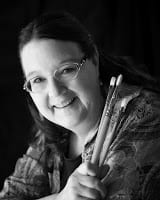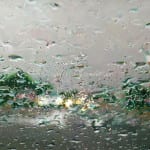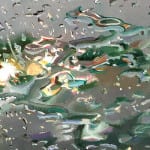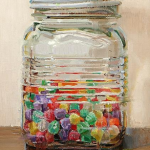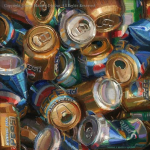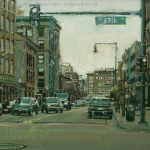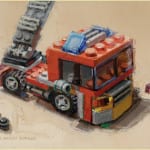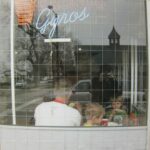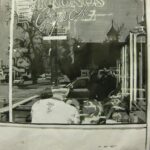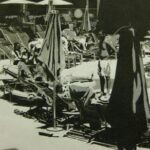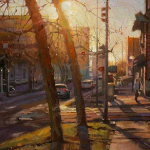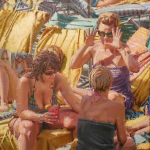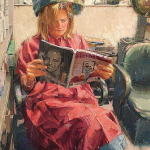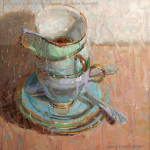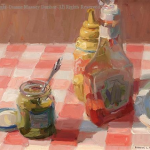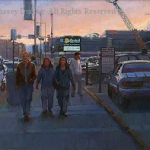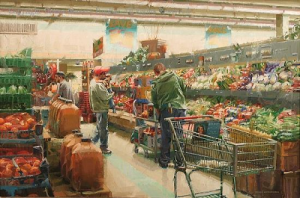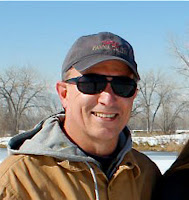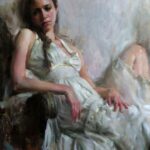
Gold Medal Mary Qian“Gaze”
This painting has strong composition, good technical execution, and emotional content. The composition has a lovely rhythm of repeating curves in the figure, and the lines of the composition direct the eye to the face that is the focal point and central to the emotional success of the painting. This focal area is further accentuated by the beautiful skin tones, bright lights in the garment, and darker values in this area of the canvas.
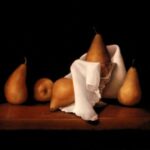
Silver MedalSusan Budash“A Pear Dressed for Dessert”
The artist makes a quiet and serious statement with this classical style still life, and then gives it her own twist with a whimsical theme. It has a compelling composition, with the pear draped in white linen cloth as a dramatic focal point, which has the power to pull you in from across the room. There is a nice rhythm of repeating lines of the forms and a harmony of color and form that makes it especially pleasing to the eye.
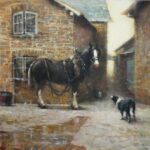
Bronze MedalElizabeth Polli OPA“Nine Days of Fog”
This painting represents a good example of an artist who has developed her own recognizable style of painting and choice of subject matter. The piece has strong composition, designed with lines that converge and serve to focus the eye on the center of interest, which is the horse’s face. Focus here is further accomplished by making this the lightest area of the image and through the position and attention of the dog. She has also created has a great feeling of atmosphere.
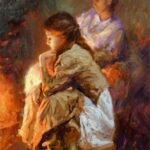
American Art Collector Award of ExcellenceVadim Dolgov“By the Fireplace”
This painting has a great sense of mood that draws me in to the intimacy and warmth of the scene. It has strong composition with the foreground figure’s face as a compelling focal point. The artist has skillfully, and to me magically, used the application of thick paint and bold, loud brushstrokes to create a sense of quiet and introspection.
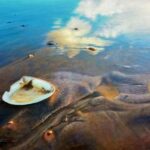
Fine Art Connoisseur Magazine Award of ExcellenceDana Malcolm“What Will Be”
The artist has created a unique presentation of common subject matter, with compelling composition and lovely flow of line. The foreground shell serves as a strong center of interest. The reflected clouds and sky light in the water give it a dreamy, otherworldly quality that lifts the subject matter from the physical to the concept of something spiritual, which is reflected in her choice of title for the painting.
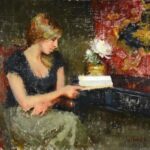
McBride Gallery Award of ExcellenceWilliam Schneider OPA,“Final Chapter”
This painting has wonderful composition that is set up by the use of light that directs the eye in a circular pattern from the book to the arm and face of the figure to the flower. This has the effect of holding me to that place and drawing me into this space the artist has created. It is a painting that really holds up from across the room, where the technique disappears and the figure appears lifelike. I feel as if I am having for myself the artist’s experience of this setting.
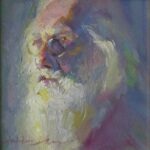
Award of ExcellenceHai-Ou Hou“Bearded Man”
The artist does so much in this painting with great economy of brushwork. She has created a very sensitive portrait of this “gentle man”. Her portrayal has a gentleness about it that is further supported by the quiet blue tones she has chosen. It is a simple and very clear statement of her impression of the subject.
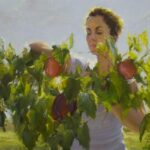
Award of ExcellenceBrandi Neighbors“Subtle Deception”
The artist has been able to convey with economy of brushwork and pleasing harmony of color and line a refreshing sense of the outdoors. I feel the sunlight and movement of the air. She achieves this suggestion of gentle movement through subtle use of value changes. There seems to be stillness only in the woman’s expression, which makes this part of the painting become the focus of attention and expression of the concept of the piece.
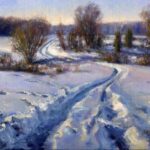
Award of ExcellenceTony Damico“Snow Tracks”
This painting is a wonderful composition with a fresh and lively plein air feel. The sunlit banks of the tracks, with the brightest lights in the image, serve to direct the eye through the landscape, drawing the viewer into the scene. This vertical movement is echoed in the placement of the trees, and there is a nice counterbalance that is accomplished by the darker value horizontals of the landscape.
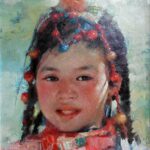
Award of ExcellenceJan Peng Wang OPA“Tibet Girl”
The artist skillfully uses clean bright color and expressive brushwork to convey a sunny atmosphere and open fresh quality to a child’s face. It is a sweet and lively statement in a small image.
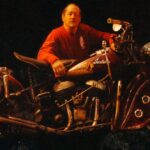
Gold MedalCraig Tennant OPAM“Jim’s Indian”
The artist has created a powerful statement of ownership and attitude, with design, chiaroscuro, and color that conveys this man’s don’t-mess-with-me-or-my-bike attitude and attachment to his Indian. We quickly focus on the bright red shirt, arm extending toward the viewer, and brighter highlights from the bike. The placement of the bike, aligned perpendicular to the viewer and extending beyond the frame of the image, creates a bold and contemporary look to the subject painted in a classical style. Although the painting is detailed, there is softness to the treatment of these details that allows me to think both the artist and “Jim” have a soft place in their hearts for this bike.
